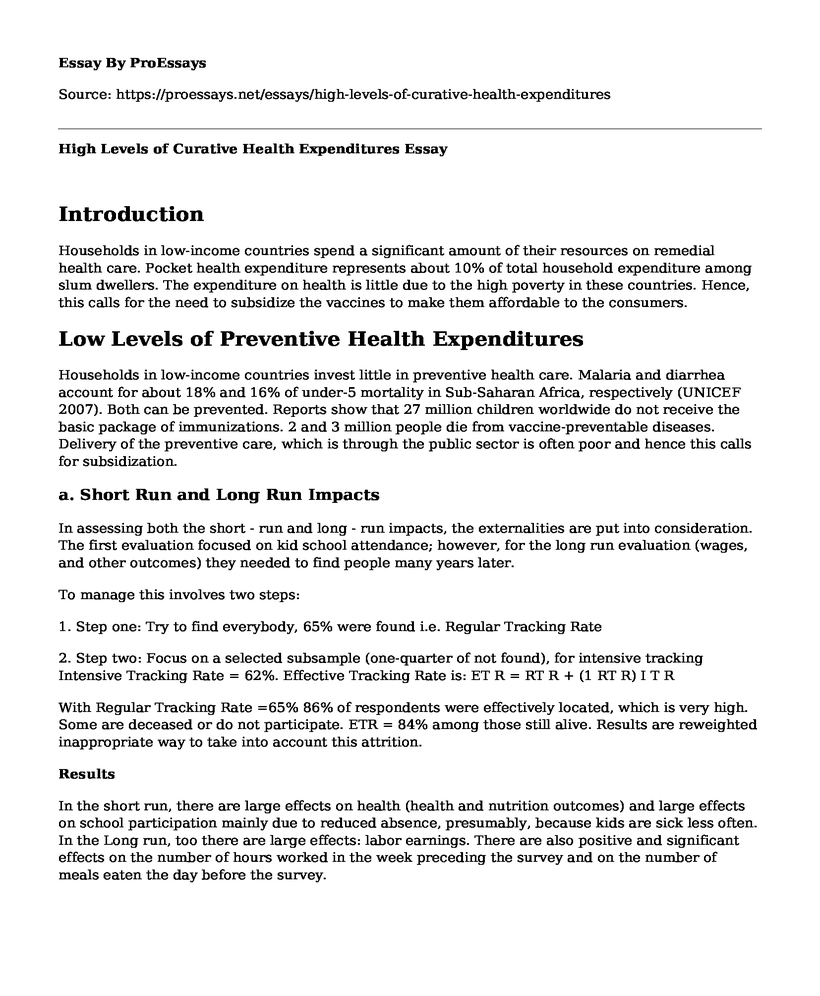Introduction
Households in low-income countries spend a significant amount of their resources on remedial health care. Pocket health expenditure represents about 10% of total household expenditure among slum dwellers. The expenditure on health is little due to the high poverty in these countries. Hence, this calls for the need to subsidize the vaccines to make them affordable to the consumers.
Low Levels of Preventive Health Expenditures
Households in low-income countries invest little in preventive health care. Malaria and diarrhea account for about 18% and 16% of under-5 mortality in Sub-Saharan Africa, respectively (UNICEF 2007). Both can be prevented. Reports show that 27 million children worldwide do not receive the basic package of immunizations. 2 and 3 million people die from vaccine-preventable diseases. Delivery of the preventive care, which is through the public sector is often poor and hence this calls for subsidization.
a. Short Run and Long Run Impacts
In assessing both the short - run and long - run impacts, the externalities are put into consideration. The first evaluation focused on kid school attendance; however, for the long run evaluation (wages, and other outcomes) they needed to find people many years later.
To manage this involves two steps:
1. Step one: Try to find everybody, 65% were found i.e. Regular Tracking Rate
2. Step two: Focus on a selected subsample (one-quarter of not found), for intensive tracking Intensive Tracking Rate = 62%. Effective Tracking Rate is: ET R = RT R + (1 RT R) I T R
With Regular Tracking Rate =65% 86% of respondents were effectively located, which is very high. Some are deceased or do not participate. ETR = 84% among those still alive. Results are reweighted inappropriate way to take into account this attrition.
Results
In the short run, there are large effects on health (health and nutrition outcomes) and large effects on school participation mainly due to reduced absence, presumably, because kids are sick less often. In the Long run, too there are large effects: labor earnings. There are also positive and significant effects on the number of hours worked in the week preceding the survey and on the number of meals eaten the day before the survey.
b. Sustainability of the Policy
For sustainability, there has to be financial, managerial and technical that will ensure that the projects are still in progress once the donors funds are withdrawn. For example Kenyan, borehole wells were useless ten years after the shift from external donor support for well water activities that generate positive externalities are advocates of sustainability emphasize the importance of local project ownership. These efforts rely on voluntary activities of the community members. The idea that the development projects should aim at financial sustainability through local voluntary action has had the tremendous influence on development thinking, in areas from microfinance to the environment. In public health and water supply, sustainability calls for concentrate on cost recovery from beneficiaries, again the deworming program in Kenya that has been sustainable for a long time. In a large water project in the community mobilization health education, building wells or subsidizing medical treatments that generate externalities.
c. How to Decide Which Policy to Implement
In knowing which policy to undertake one has to assess the costs and benefits involved. The costs are subtracted from the benefits then the Net Present Value (NPV) of the policy is found and compared. Implement the policy if its benefits are higher than its cost. If there is a limit on total revenues: implement the policies that are the most cost effective. For instance Measurement of benefits in Health and Education; Education: use the private returns to education and how it affects wages. Health: the market value of better health. Benefits will also involve the measurement of the positive externalities that is Health and Education spillovers.
Costs include direct and indirect costs. The cost of tax revenues is also cost. The direct cost this includes time of delivery and all direct costs incurred to do mass treatment, NGO, and labor. Indirect costs are cost from negative externalities, the deadweight loss and opportunity costs of time spent at school. The average per capita opportunity cost of time generated
Implementation of a Policy
If the Benefits of a policy are much higher than the costs policy should be implemented. If the two policies have both positive Net Present Value (NPV), the policy with the higher net present value is selected because it has more return than the other policy.
Cite this page
High Levels of Curative Health Expenditures. (2021, Apr 21). Retrieved from https://proessays.net/essays/high-levels-of-curative-health-expenditures
If you are the original author of this essay and no longer wish to have it published on the ProEssays website, please click below to request its removal:
- Paper Example on Health and Social Care
- A Policy for the Americans With Disabilities Act (ADA) Essay
- Research Paper on Prevention and Cessation of Tobacco Use
- Pregnant Women Need Nutrients for Healthy Baby: Know Why
- Essay Sample on Promoting Health & Reducing Risk: Basics of Community/Public Health
- IMF & WB: Criticisms & Conditionality Policy - Essay Sample
- Paper Sample on Eli Lilly: A Case Study on Changes in Pharmaceutical Industry







